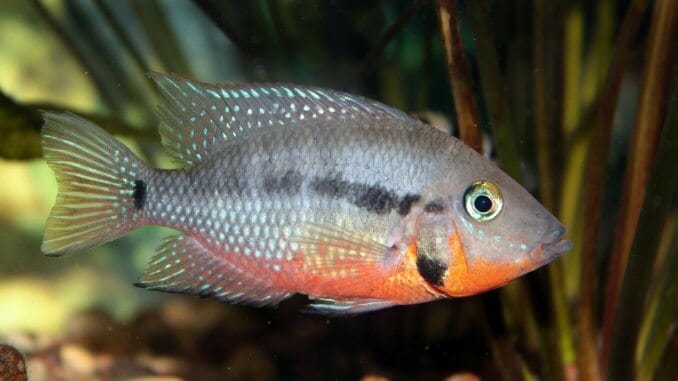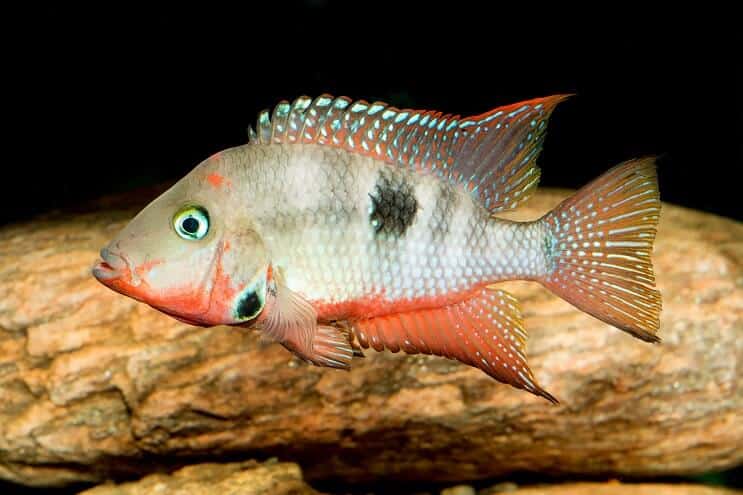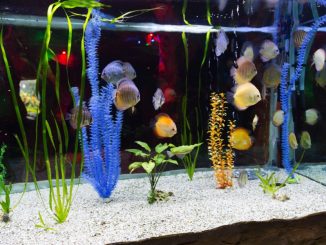
The firemouth cichlid is a great addition to your freshwater aquarium. If you are looking to add some color to your tank, one of these cichlids could be the perfect fish for you.
This brightly colored fish is easy to care for. They are hardy and peaceful but very territorial and bring a fiery flair to your tank.
If you are a new fish keeper don’t worry, this article will help you through all you need to know to successfully keep and breed firemouth cichlids.
TABLE OF CONTENTS
Firemouth Cichlid Facts & Overview

| Category | Rating |
| Care Level: | Beginner |
| Temperament: | Semi-aggressive |
| Color Form: | Red and grey |
| Lifespan: | 15 years |
| Size: | 7 inches |
| Diet: | Omnivore |
| Family: | Cichlidae |
| Minimum Tank Size: | 30 gallons |
| Tank Set-Up: | Freshwater, plants and sandy substrate with caves |
| Compatibility: | Active fish of similar size |
The Firemouth Cichlid (Thorichthys meeki), is a member of the Cichlidae family and is found in the rivers of Central America.
Today it is considered an invasive species in North America, and has also been recorded in other areas around the world. Following human release in the wild and because of its great adaptive skills and fast growth rate, it is also found in the Philippines, Singapore, Israel, and Australia.
Thanks to its bright red coloration, it is a popular fish in the ornamental aquarium trade and is typically bred commercially.
They are hardy, peaceful fish. If you are just starting out fish keeping, this may well be the fish for you.
It is semi-territorial and can become aggressive during spawning seasons.
If properly cared for, Firemouths can live for 8-10 years.
Their scientific name Thorichthys meeki is divided into two parts. Thorichthys from the ancient Greek meaning “leaping fish”, and meeki named after the expert Ichthyologist Seth Eugene Meek (1859-1914) who was the first to write a book on Mexican freshwater fish.
Typical Behavior
The Firemouth Cichlid is a peaceful but territorial fish.
It is not very good at handling stress and prefers larger tanks with more space; this helps them carve out separate territories.
They are not schooling fish, and in their natural habitat males tend to live separately tending to their own territory.
They are monogamous and are excellent parents. Males will extend their gills and show off during spawning or as a warning to other fish to stay away from their territory.
If you watch them closely you will notice they spend a lot of their time around plants. They like to rearrange and move things. This includes the substrate and your fish might also try to move or dig out the plants.
Keep an eye out so the plants don’t get too damaged.
Appearance

The Firemouth Cichlid gets its name from the bright red coloration that males develop during spawning seasons.
Like most fish, males and females of this species look different. Usually, males are larger and show brighter coloration with longer fin rays. On the other hand, females show larger bellies giving them a more rounded shape.
Generally, males reach about 6 inches while females are a bit smaller at 4-5 inches. Heads and bodies have a grey to blue-olive coloration with the males showing bright red or orange colors on the underside of the head where the gills are.
A characteristic of all Firemouth Cichlids is a black mark on the lower half of the operculum. They can also have dark lateral bars along the sides.
Their fins, with the exception of the pectoral fins, have a red edge with occasionally blue spots.
Having fins like rays is typical of the fish class Actinopterygii. This class is also known as ray-finned fishes. The fins of the fish in this class are formed by a web of skin supported by a set of rays or spines.
Interestingly, it has been shown that these fish have a different coloration depending on their natural habitats. If you want to find the most colorful fish, then you should go to the lower Grijalva in the state of Tabasco, Mexico.
Habitat and Tank Conditions

Central America is the home of the Firemouth Cichlid. Its natural habitat is the shallow and turbid waters of the rivers in the Yucatán Peninsula, Mexico Belize, and northern Guatemala.
The rivers here are slow-moving with muddy and sandy river beds. Usually, they spend most of their time in the lower or mid-section of the river trying to enjoy the protection of the vegetation close to the shoreline.
Occasionally, Firemouths also enjoy the protection of caves formed by sunken wood or rocks.
It is now considered an invasive species and has also found a home in Puerto Rico and in the states of Hawaii, Arizona and Florida.
Tank Conditions
When setting up their tank try to keep in mind that if you replicate their natural conditions as much as possible, you will reduce the chances of your fish getting sick.
It needs warm temperatures, 75-86°F with a pH ranging between 6.5-8.0. Water hardness should be kept between 8-15 dGH and water movement should be moderate. The ideal substrate would be sand.
Even though Firemouths are freshwater fish, they can withstand moderate brackish water conditions, tolerating salinity that is about 10% of a normal seawater tank.
One of the most significant things for this fish is a good filtration system. The water must be clean with no ammonia and harmful nitrogen compounds such as excessive levels of nitrite and nitrate.
When setting up the tank, try to provide plenty of hiding spaces using wood or rocks and plants. Plants should be a bit hardy as they like to ‘play’ with them; Sagittaria is ideal. Make sure to pot your plants so the roots are protected.
Try to set the plants around the edges of the tank leaving space for swimming in the middle.
Finally whilst they are not particularly affected by the light, moderate lighting should be used.
What Size Aquarium Do They Need?
The ideal tank size for a pair of Firemouth Cichlid is 30 gallons. However, larger is always better especially if you want to keep other fish as well.
How Many Can Be Kept Per Gallon?
A single Firemouth can be kept in a 15 gallons tank. However, we advise that you purchase a pair, and they should be kept in a minimum tank size of 30 gallons.
Tank Mates
Firemouth Cichlids are the ideal fish in a community aquarium with tank mates of a similar size. They are peaceful fish except when spawning. During this season, they may become aggressive towards other fish and potentially kill any fish invading their territory.
Just keep an eye on your fish and if necessary, think about removing the threatened fish from the tank during spawning.
Males can suffer from harassment from larger and more aggressive tank mates while females are quite good at finding protection under the other fish in the aquarium.
Suitable tankmates could be another similar size South American Cichlids. Make sure to provide a tank large enough to give the fish the opportunity to safely establish their own territory.
Ideal tank mates are active schooling fish such as tetras (serpae, lowlight, and rummy nose) and catfish (such as pictus catfish).
It is best to avoid slow-moving fish and species easily bullied such as dwarf cichlids and angelfish.
Also, shrimp and snails might get eaten.
Keeping Firemouth Cichlids Together
Firemouth Cichlids are not schooling fish but they do like company from fish of the same species if enough space is provided. Initially, it is best to purchase a pair.
How To Care For A Firemouth Cichlid
Firemouths Cichlids are pretty hardy and if you keep a close eye on water conditions you shouldn’t have any problems.
Like with most freshwater fish, infections can be a major problem for them such as parasitic, fungal, and bacterial infections. One of the most common is the ich disease. You will see white spots on their body, mainly on the gills and fins.
Fortunately Ich disease with this fish is relatively easy to treat. Firemouth Cichlids can tolerate relatively high-water temperatures, as high as 86°F for a few days. Try to increase the temperature of the water and if this is still not enough you can treat them with copper-based medicines.
However prevention is better than cure. Try to reduce any form of stress by creating the best possible living conditions for your fish; check water parameters, a good diet, and suitable tank mates.
Also keep in mind that any new external object (alive, dead or synthetic) that you add to your aquarium, can be considered a harmful carrier of bacteria, parasites or fungi.
In this situation it is recommended you meticulously clean it before adding it to the tank.
Diet

Firemouth Cichlids are not fussy eaters. They will feed on pretty much anything you give them.
In their natural habitats you find them feeding on small crustaceans such as copepods and cladocerans, organic detritus, small invertebrates, and molluscs. This is why having shrimp and snails as tank mates might not be the best idea.
If you carefully observe them, you might spot your fish sifting through mouthfuls of substrate; they are looking for food.
A varied diet is a key part of their health. You can feed your Firemouth Cichlids twice a day in small portions. They will eat flake, live and frozen food.
We suggest providing a high-quality diet by feeding high-quality pellets or flakes.
You can also feed them vegetables such as spinach, spirulina, and a meaty supplement such as brine shrimp or blood worms. Artemia, mosquito larvae and Tubifex are also good supplements.
Breeding

Similar to other cichlids, the Firemouth form monogamous pairs and make great parents to their fry. If you don’t already have a formed pair it is easier to let them pair off themselves by buying 6 or at a time.
They don’t require specific water conditions for breeding. However, you can easily induce spawning by setting water parameters to a pH of 7.0 with temperatures between 75°F to 79°F and a water hardiness of 10 dGH.
Eggs are usually laid on a carefully cleaned solid surface such as a flat rock, large leaves, wood, or directly on the glass surface of the tank.
The female usually lays about 100-500 eggs and then the male will fertilize them. The parents ferociously guard the eggs and subsequently, the fry. Adults can raise several broods per year.
Fry are easy to feed, as long as you choose good quality food such as Artemia nauplii and microworms.
They should reach the free-swimming stage after 4-5 days and their parents will continue to raise and care for them for several weeks.
Is the Firemouth Cichlid Suitable For Your Aquarium?
Firemouth Cichlids are perfect fish for beginners. Even though they can be quite aggressive while spawning, they are quite hardy fish.
They are a colorful addition to your tank with their bright red mouth and also bring interesting territorial behavior.
The good news is they are not difficult fish to care for and they eat pretty much anything. Keep good water quality and feed them regularly and you will have healthy fish.
Are you ready to keep such a fiery fish? Please let us know what you think in the comments section below…







Good article – If you can give additional information about how they handle stress would be greatly appreciated. We lost 3 within two days, I believe from heart attacks. Each one started swimming erratically. After running into the glass, the ornaments etc, they’d hit the bottom, all this in a 100 gallon aquarium. This behavior started after having them for about 3 weeks. I noticed they started hiding more, then when either of us would get close to the tank, they would start this behavior. Ammonia=0, Nitrites=0, Nitrates=0, test with API liquid test kit. Water changes weekly. Other tank mates, Blood Parrots, 2 approximately 3″ and 1 large (approx 10″). 525 gph canister filter (300 gph measured), UV sterilizer.
Hi Robert, I’m sorry to hear about your losses. I haven’t experienced this with firemouth cichlids but I’ll leave your comment here in hope that someone might have had a similar experience and answers to share with you. Robert
I’ve had mine for a year now and I find just like severum and discus they don’t like change. Anything out of their routine and they give me an evil eye for a couple of days. So when they’re not used to a lot of action moving them and new tankmates environment etc. might have stressed them too much. To be on the save side you could try a temporary divider and make sure to give them a nice dark place as well as plants to hide. They may dig up some plants but at least it keeps them busy. Good luck.
Sorry to hear about your fish ,I had Firemouths many years ago and had a similar situation where they were agitated but the reason for this was because of more than usual activity in my home with lots of foot traffic due to a remodel. My solution was to cover the front of the tank with a heavy cloth and then remove it at night once the activity died down which greatly helped .
Great article! I accidentely ended up with two firemouths (asked for african butterflies). In addition, the two appear to be both males. But I am not 100%syre about that: the smaller, more slender one is more dominant and chases the bigger, plumper, more colorful one.
They are at the moment in a softwater tank together with dawn tetras, glowlight danios, and panda corys. For the moment the firemouths show no interest in the smaller fish, but i guess it’s just a matter of time until the will eat them. Can/sould I transfer the firemouths into my molly tank? Water parameters are within the range of both species and in nature the occupy the same habitats, right? It’s a 65g tank, heavily planted, and i added tons of stones and roots to offer hidibg places and that would let them establish teritories. Or should i return them to the store?
Hi Christian, yes they inhabit the same areas in the wild so the water conditions would be fine. With it being heavily planted, this too is a good match for them. I would be tempted to introduce them to the Molly tank and keep a close eye on them for the first week or two to ensure everyone is getting a long. Many thanks, Robert
I have 2 firemouth and they are amazing fish only thing is I think they are 2 males who at the moment are in same tank and also got 2 Angel fish and 2 plecos in a 105 gallon tank and I’m watching them swim and even seen a firemouth swim with one of the angels it is nice to see atm fish getting on atm and I’m from the UK